Isset in PHP is an very important in-built PHP serve as that makes your PHP program extra self-explanatory. Alternatively, even the PHP guide has now not defined the isset serve as intensive. On this article, you’ll glance into the isset serve as, in addition to its quite a lot of facets intensive.
While you write a small piece of code, you’ll stay monitor of what number of variables you may have used or the names of the variable you may have used for your code. However each time you’re coping with a big program that accommodates a couple of variables at the side of a couple of arrays or array keys, there’s a top risk that you just lose monitor of what variable names or array names are already used and names now not used but used for your code. In such instances, the isset serve as comes into the image.
What’s isset() in PHP?
The isset serve as in PHP is used to decide whether or not a variable is about or now not. A variable is regarded as as a suite variable if it has a worth instead of NULL. In different phrases, you’ll additionally say that the isset serve as is used to decide whether or not you may have used a variable for your code or now not earlier than. This is a boolean-type serve as. It implies that if a variable, array, or array key isn’t set or it has a NULL worth, the isset in PHP will go back false, another way, you’ll get true because the go back worth. You’ll be able to move a couple of arguments within the isset serve as and it is going to test for all of the handed parameters whether or not or now not they’re set. On this case, the isset serve as will go back true provided that all of the handed arguments are set. If any of the arguments have a NULL worth, the isset serve as will go back false.
isset() Syntax, Parameters and Go back Values
Syntax of isset in PHP:
// syntax to test if the
// handed variables are declared
// and now not equivalent to null or now not,
// the use of the isset serve as in PHP.
isset ( blended $var1 , blended $var2, …$vars )
The parameters used within the syntax:
The parameters handed are blended variables. This merely implies that you’ll move a number of variables of various knowledge varieties to isset in PHP as parameters.
Go back worth:
The isset() returns a boolean worth. It’ll go back true if the parameter handed is said and isn’t set NULL. Within the case, the place over one parameter is handed (they are able to be of various knowledge varieties), the isset() will go back true provided that all of the handed variables don’t seem to be equivalent to NULL and their values exist.
It’ll go back false when a variable has now not been declared or is the same as NULL. If there’s a couple of parameter handed, and if any of them is unset, then the returned end result will probably be false, without reference to the set/unset standing of different variables.
The next program illustrates the isset in PHP.
<?php
// variable of string variety,
// having empty string as its worth
$var1 = ”;
// variable of integer variety,
// having 1 as its worth
$var2 = 1;
// variable of string variety,
$var3 = “testValue”;
// variable assigned as NULL
$var4 = NULL;
// will print true, as variable exists
// and isn’t equivalent to NULL
var_dump(isset($var1));
var_dump(isset($var2));
var_dump(isset($var3));
// will print false, as variable
// is the same as NULL
var_dump(isset($var4));
// will print false, as variable does now not exist
var_dump(isset($var5));
// will print true, as all of the variables
// exist and now not equivalent to NULL
var_dump(isset($var1, $var2, $var3));
// will print false, as var4 is equivalent
// to NULL
var_dump(isset($var1, $var2, $var4));
?>
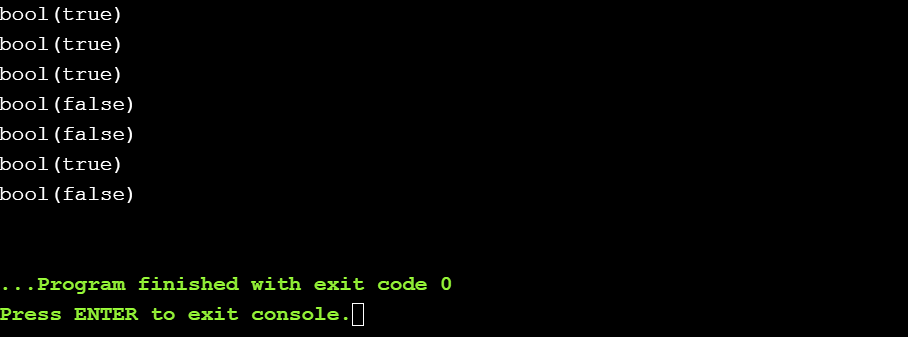
Our Unfastened Lessons with Certificates
PHP isset() Serve as
Instance: Test if a variable is empty and whether or not the variable is about/declared.
|
<?php $a = 0; // True as a result of $a is about if (isset($a)) { echo “Variable ‘a’ is about.<br>”; } $b = null; // False as a result of $b is NULL if (isset($b)) { echo “Variable ‘b’ is about.”; } ?> |
Definition and Utilization
The isset() serve as determines whether or not a variable is about. To be thought to be a suite, it must now not be NULL. Thus, the isset() serve as additionally assessments whether or not a declared variable, array or array key has a null worth. It returns TRUE when the variable exists and isn’t NULL; else, it returns FALSE. Moreover, while you provide a couple of variables, then the isset() serve as will go back true provided that all of the variables are set. The unset() serve as unsets a variable.
Syntax
The isset() serve as has the next syntax:
Parameter Values
The isset serve as accepts a couple of parameter. The primary parameter of this serve as is $var. This parameter is used to retailer the price of the variable.
Parameter |
Description |
|
variable |
Required. It retail outlets the price of the variable and specifies the variable to test. |
|
… |
It’s non-compulsory. It specifies every other variable to test. |
Technical Main points
|
Go back Sort |
Boolean |
|
ReturnValue |
TRUE: If the variable exists and isn’t NULL. Else it returns false. |
|
PHP Model |
4.0+ |
|
PHP Changelog |
PHP 5.4: Strings’ non-numeric offsets now go back FALSE. |
Why Test Each isset() and !empty() Purposes in PHP?
The isset() serve as assessments whether or not a variable is about and isn’t NULL. Its syntax is as follows:
|
bool isset( $var, blended ) |
Instance:
|
<?php // PHP program as an example // isset() serve as $num = ‘0’; if( isset( $num ) ) { print_r(” $num is about with isset serve as <br>”); } // Claim an empty array $array = array(); // Use isset serve as echo isset($array[‘simplilearn’]) ? ‘array is about.’ : ‘array isn’t set.’; ?> |
Output:
|
0 is about with isset serve as array isn’t set. |
The empty() serve as determines whether or not the precise variable is empty or NULL. The !empty() serve as is the supplement of empty() serve as. So, the empty() serve as is the same as !isset() serve as whilst the !empty() serve as is the same as isset() serve as.
Instance:
|
<?php // PHP program as an example // empty() serve as $temp = 0; // It returns true as a result of // $temp is empty if (empty($temp)) { echo $temp . ‘ is regarded as empty’; } echo “n”; // It returns true since $new exist $new = 1; if (!empty($new)) { echo $new . ‘ is regarded as set’; } ?> |
Output:
|
0 is regarded as empty 1 is regarded as set |
Explanation why to Test isset() and !empty Serve as
The isset() and !empty() purposes are moderately very similar to one every other. Each go back the similar effects. Alternatively, the main distinction is that the !empty() serve as does now not generate any caution or e-notice if the variable does now not exist. Subsequently, the use of both of the 2 purposes is sufficient and together with each purposes in a program ends up in needless reminiscence utilization and time-lapse.
Instance:
|
<?php // PHP serve as to exhibit isset() // and !empty() serve as // initialize a variable $num = ‘0’; // Test isset() serve as if( isset ( $num ) ) { print_r( $num . ” is about with isset serve as”); } // Show new line echo “n”; // Initialize a variable $num = 1; // Test the !empty() serve as if( !empty ( $num ) ) { print_r($num . ” is about with !empty serve as”); } |
Output:
|
0 is about with isset serve as 1 is about with !empty serve as |
PHP Error Reporting
PHP error reporting is the most important idea, particularly when you find yourself figuring out the makes use of of isset, empty, and Null in PHP. The systems written within the PHP programming language don’t seem to be transformed into an executable report, as a substitute; it immediately executes them from the supply code. The cause of that is that PHP isn’t compiled, as a substitute, it’s interpreted and is administered immediately. So, this will purpose issues each time there are mistakes in a program, because the mistakes which can have been detected all through the compilation procedure, best get stuck on the runtime.
Now, there are various kinds of mistakes, they are able to be both trivial mistakes referred to as E_NOTICE that don’t purpose a lot of a distinction or destructive mistakes referred to as E_ERROR that may even result in the crash of this system. Those mistakes in PHP are displayed within the output through default. You’ll be able to additionally configure the php.ini report to redirect those mistakes to a log report, or you’ll disable them from being exhibited to the output. You’ll be able to configure and customise directives named display_errors and error_reporting to be had within the report named php.ini. Those error reporting ideas are very important for builders to know and practice when they’re growing an software, as mishandling of mistakes can lead to a complete software crash.
Dealing with the mistakes of the kind E_NOTICE, which can be trivial, can also be fairly simple. Some errors made through the programmers that purpose E_NOTICE mistakes are the wrong declaration and utilization of variables. If a program is making an attempt to get admission to a non-existing variable, then it could purpose an E_NOTICE variety error. This can also be brought about through an error in common sense or some typing mistake. There will also be a case the place you could wish to know if a variable for your program exists or now not. In such instances, the isset and empty can end up to be very important.
Unset() Serve as in PHP
The unset() serve as is every other essential in-built serve as equipped through PHP. The unset() serve as is used to unset a specified variable. The capability of the unset() serve as depends upon the serve as name. If the unset() serve as has been referred to as on a variable this is inside of a user-defined serve as, then that variable gets unset in the community. The scope of the unset() serve as will probably be inside of that serve as. For those who use a variable with the similar title as earlier than in some other user-defined serve as, it is going to now not be unset and can retailer the price which the consumer has explained. If you’re keen to unset an international variable, you’ll use the $GLOBALS array. The unset() serve as returns not anything.
Syntax of unset in PHP:
// syntax to spoil variables
// through passing them to unset()
unset ( blended $var1 , blended $var2, …$vars )
The parameter within the syntax:
The parameters handed right here also are blended variables, which means you’ll move a number of variables of various knowledge varieties to the unset in PHP as parameters.
Go back values:
The go back form of unset is void. Because of this it does now not go back a worth, as a substitute, it utterly unsets a number of of the handed variables.
The running of the unset() varies if it is named inside of a serve as. As an example, for those who supply a variable that has been declared as international in a serve as, and unset() has been referred to as on that variable inside of the similar serve as, then in this kind of case, it destroys the variable in its native scope best.
The next program illustrates the unset in PHP.
<?php
// initialize a variable
$var1 = ‘1’;
echo ” Worth of the variable earlier than calling unset() is: “.$var1;
echo””;
// calling unset to spoil the variable
// unset
unset($var1);
echo ” Worth of the variable after calling unset() is: ” .$var1;
?>

Null
NULL can’t be sidelined in case you are speaking concerning the isset() serve as in PHP. A variable is claimed to be NULL if it does now not include any worth. It routinely assigned those variables as NULL. You’ll be able to assign the price of a variable as NULL manually or use the unset() serve as to assign the price NULL to a variable.
Syntax of NULL in PHP:
// syntax to assign null
// to a variable in PHP
$var = NULL;
Description of the syntax:
A variable is claimed to be NULL if it falls into one of the most following classes:
- It assigns the consistent NULL worth to it.
- It assigned no worth to it.
- unset() has been referred to as on it.
The next program illustrates the idea that of NULL in PHP.
<?php
// assign null consistent to the variable
$myVariable = NULL;
// this may print null
var_dump($myVariable);
// use $var (a null variable) to
// every other number one variables
// will print 0 for integer
var_dump( (int) $myVariable);
// will print 0 for glide
var_dump((glide)$myVariable);
// will print false for bool
var_dump((bool) $myVariable) ;
// will print false for boolean
var_dump( (boolean) $myVariable);
?>
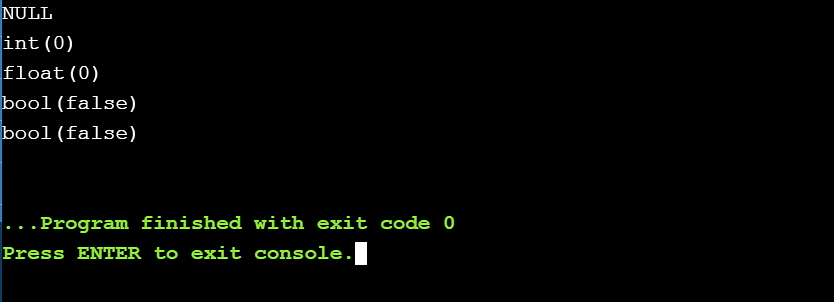
Empty() Serve as
The empty() serve as is every other necessary in-built serve as equipped through PHP. This serve as is used to test if a variable is empty or now not. This serve as is of the boolean go back variety. The empty() serve as will go back false if the variable isn’t empty and accommodates a worth that isn’t similar to 0, another way, it is going to go back true.
Syntax of empty() in PHP:
// syntax to to test
// if a variable is
// empty or now not in PHP
bool empty($var);
The parameters used within the syntax:
The empty serve as accepts a variable, array, or array key that you need to test whether or not is empty or now not.
Go back values
The empty serve as is of the boolean go back variety. It’ll go back false if the variable isn’t empty, another way, it is going to go back true.
The next program illustrates the empty serve as in PHP.
<?php
// initializing the variables with values
//that vacant() evaluates
$a = 0; //initialising the variable as 0 (int)
$b = 0.0; //initialising the variable as 0 (glide)
$c = “0”; //initialising the variable as 0 (string)
$d = NULL; //initialising the variable as NULL
$e = false;
$f = array(); //initialising the variable as an empty array
$g = “”; //initialising the variable as an empty string
$h = 91; //initializing the variable as a non 0 worth
// fthis will go back True as a has 0 (int) worth
empty($a1) ? print_r(“True”) : print_r(“False”);
// this may go back True as b has 0 (glide) worth
empty($b2) ? print_r(“True”) : print_r(“False”);
// this may go back True as c has 0 (string) worth
empty($c) ? print_r(“True”) : print_r(“False”);
// this may go back True as d has NULL worth
empty($d) ? print_r(“True”) : print_r(“False”);
// this may go back True as e has been initialised as NULL
empty($e) ? print_r(“True”) : print_r(“False”);
// this may go back True as f has an empty array
empty($f) ? print_r(“True”) : print_r(“False”);
// this may go back True as g has an empty string
empty($g) ? print_r(“True”) : print_r(“False”);
// this may go back False as h has a non 0 worth
empty($h) ? print_r(“True”) : print_r(“False”);
?>
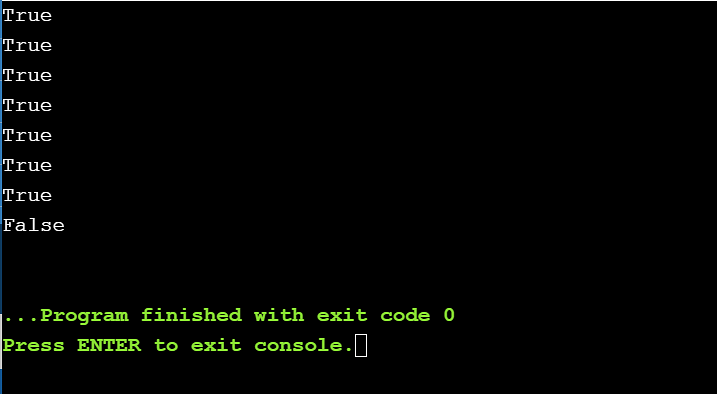
Serve as Go back Values
That is the most important segment in response to the isset() and empty() purposes. You recognize that the isset() serve as and the empty() serve as are the language constructs i.e., they’re best appropriate to variables. Therefore, for those who attempt to move a serve as as a controversy, PHP will throw a deadly error.
isset(func1())
empty(func1())
-> Deadly error: Can not use serve as go back worth in write context
However it isn’t vital to make use of those two purposes to test if the output of the serve as is isset or empty. There are alternative ways to test the similar. Initially, the serve as you need to test should exist. For those who test for a nonexistent serve as, PHP will throw an error like this:

Such mistakes are very severe and cannot be omitted. Now, since you recognize that each and every serve as has a go back variety despite the fact that it returns NULL, the similar statements for isset and !empty purposes are –
if (func1() !== null) -> similar of isset
if (func1() == true) -> similar of !empty
if (func1()) -> concise similar of !empty
if (func1() == false) -> similar of empty
if (!func1()) -> concise similar of empty
Utility
The high software of the isset and empty purposes is that it’s used to test if a variable is about or now not. Those purposes are suitable to test GET and POST strategies. The POST and the GET strategies if now not used with right kind stipulations may cause problems as a result of their much less protected nature. So, you’ll use the isset() to be sure that enter is entered within the fields, and a variable has some worth in order that you don’t procedure a NULL worth for your programs.
Instance 1:
// you’ll use the isset
// on a publish button
// to test if a variable
// is about/unset.
if(isset($_POST[‘submit’])
{
echo(“Identify is: “);
echo($_POST[‘name’]);
}
// this can be utilized in a
// shape for your software
Instance 2:
if (isset($_POST[‘userID’], $_POST[‘pass’])) {
// enter has been entered within the shape
// it is going to now attempt to log the consumer in
}
// this can be utilized in a sign-up or login shape
Epilog
There are some edge instances in regards to the isset() serve as and the empty() serve as that you want to know. As an example, let’s say you want to broaden your software in this kind of approach that it handles invalid URL requests. Right here, you’ll use the isset and empty purposes. After the use of the isset and empty purposes for your software, if there’s an invalid URL, then a 404 error web page may also be displayed.
$currentField = fetchRecordFromDatabase($_GET[‘value’]);
if (!$currentField) {
errorPage(404);
}
echo $currentField;
As already mentioned, the isset() serve as will also be used to test if an array or array key’s set or now not. Alternatively, there’s every other serve as this is only made for this function. The “array_key_exists” serve as serves instead for “isset($array[‘key’])”. Identical to the isset() serve as, this serve as additionally has a boolean knowledge variety and returns true if the array key exists, another way returns false. This serve as can come across the precise distinction between a no worth and NULL.
$array = array(‘arrayKey’ => null);
// will go back false
var_dump(isset($array[‘arrayKey’]));
// will go back true
var_dump(array_key_exists(‘arrayKey’, $array));
Alternatively, the isset() serve as by myself is enough for such instances. Whilst coping with the variables, it’s the similar factor for a programmer, whether or not a variable has no worth or is about as NULL. So, you’ll nearly reach the similar capability with the isset () serve as too. However if you wish to explicitly print the price of a NULL variable as ‘null’, then the array_key_exists serve as will will let you do the similar.
Examples
-
Distinction Between NULL Personality and NULL Consistent
In PHP, the null persona (‘�’) and the NULL consistent don’t seem to be the similar. While you name the isset() on a null persona, it is going to go back true, as it’s other from the NULL consistent.
Imagine the next instance to make the above level transparent.
<?php
/********** isset on a variable that has been
assigned some worth ************/
$varWithValue = 11;
$value1 = isset($varWithValue);
// this may print true,
// the variable isn’t equivalent to NULL
echo var_dump(isset($value1));
echo “”;
/********** isset on a variable that has been
assigned NULL consistent ************/
$varNullConstant = NULL;
$value2 = isset($varNullConstant);
// this may print false,
// the variable is the same as NULL
echo var_dump(isset($varNullConstant));
echo “”;
/********** isset on a variable that has been
assigned NULL consistent ************/
$varNullCharacter = ‘�’;
$value3 = isset($varNullCharacter);
// this may print true,
// the variable is the same as a null persona,
// and now not the NULL consistent
echo var_dump(isset($value3));
echo “”;
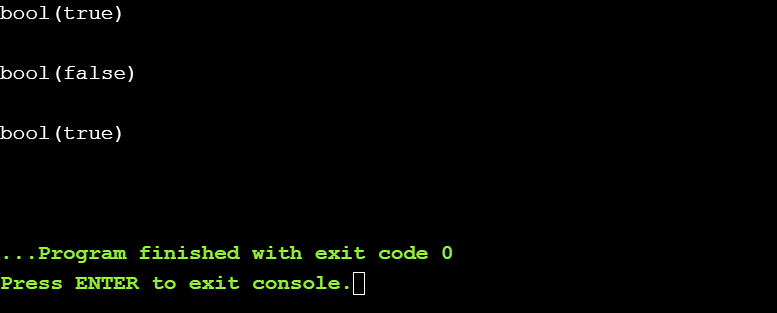
The unset() serve as destroys the variable on which it is named. You’ll be able to move a couple of variables of blended knowledge varieties, and it is going to spoil or unset they all.
Imagine the next instance to peer the running of the unset() in PHP.
<?php
// stating check variables
// for checking out the habits
// of the unset serve as.
$var1 = ’10’;
$var2 = ‘testString’;
// standing of the variables earlier than unset is used.
if (isset($var1) && isset( $var2)) {
echo “We’re the variables having values:”;
echo $var1;
echo $var2;
echo “”;
var_dump (isset($var1));
var_dump (isset($var2));
echo “”;
}
// unset serve as is named
unset ($var1);
unset ($var2);
echo “The statues of the variables after calling unset() in them:”;
var_dump (isset($var1));
var_dump (isset($var2));
?>
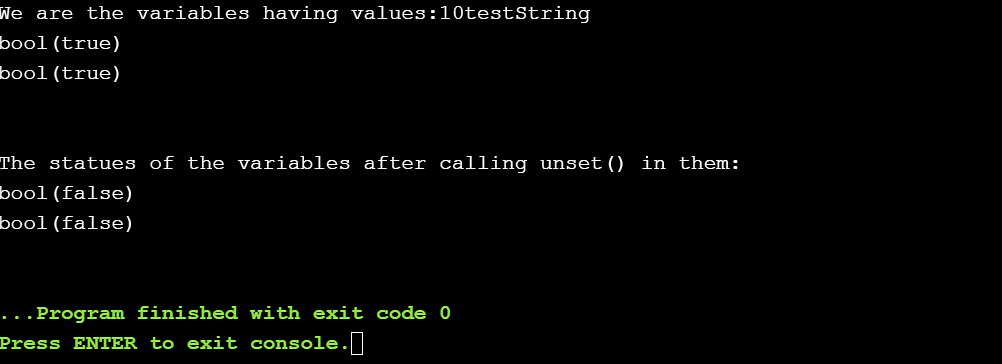
-
Distinction Between isset and !empty
The main distinction between isset and empty lies in the truth that the latter does now not throw any warnings in case the variable handed to it does now not exist. While a caution is displayed if the isset serve as is used. As opposed to this, either one of them are identical on the subject of their go back values and utilization.
Imagine the next instance to know the variation between the isset and empty in PHP.
<?php
// stating a check variable
// to test the variation within the
// functioning of
// isset and empty.
$var = NULL;
//name isset() on var
echo “Right here isset is named.”;
var_dump(isset($var));
echo “”;
//name empty() on var
echo “Right here empty is named.”;
var_dump(!empty($var));
echo “”;
?>

-
Checking A couple of Variables
The isset serve as in PHP can test a couple of variables having other or blended knowledge varieties in a single cross. You’ll be able to merely move those variables because the parameters. It’ll go back true if all of those variables exist and don’t seem to be NULL. If any of them is NULL, then a false worth will probably be returned.
Imagine the next instance to test a couple of variables the use of isset in PHP.
<?php
$var1 = 1;
$var2 = ‘testString’;
$var3 = ”;
$var4 = ‘ ‘;
if (isset ($var1, $var2, $var3, $var4)) {
echo “All variables exist and they don’t seem to be equivalent to NULL.”;
echo “”;
}
else {
echo “One or a couple of variable does now not exist, or have a NULL worth.”;
}
?>

-
isset() to Test Consultation Variable
The isset serve as will also be used to test the values of the consultation variables, storing data such because the username, userID, and different knowledge this is explicit to the customers on a internet web page.
Imagine the next instance to know the running of isset in PHP with consultation variables.
<?php
// variable conserving the title of the consumer
$myUser = ‘testUser’;
// assign the title of the consumer
// to the consultation’s userID
$_SESSION[‘userID’] = $myUser;
// checking if the consultation variable
// userID exists and has a non-NULL worth or now not.
if (isset($_SESSION[‘userID’]) && !empty($_SESSION[‘userID’])) {
echo ” That is an to be had consultation.”;
} else {
echo “There is not any consultation to be had.”;
}
?>

Explanation why to Test Each isset and empty
The !empty() serve as acts because the supplement of the empty() serve as. The !empty() serve as is significantly similar to the isset() serve as and empty() serve as is similar to the !isset() (praise of the isset() serve as) serve as. Each the !empty() serve as and the isset() serve as have identical capability. The use of either one of the purposes will lead to greater time complexity and reminiscence wastage. However there is a slight distinction between either one of those purposes. Whilst checking if a variable exists or now not, the empty() serve as does now not notify the programmer or give any more or less caution.
Get spotted through best hiring corporations thru our JobAssist program. Get whole activity help submit the Submit Graduate Program In Complete Stack Internet Construction Direction and unharness the unending probabilities. Get involved with our admission counselor TODAY!
Wrapping Up!
On this article, you realized concerning the isset serve as in PHP. You explored what the isset() serve as does and understood its syntax and parameters intensive. You noticed the unset() serve as and empty() serve as at the side of their syntax and utilization. This newsletter additionally explored the variation between null persona and NULL consistent. It mentioned the explanation to test each the isset() serve as in addition to the empty() serve as.
To get began with PHP, you’ll confer with this video.
Don’t simply prevent right here. To be told MEAN stack construction and to present your self an opportunity to paintings for best tech giants, take a look at our route on Submit Graduate Program In Complete Stack Internet Construction. On this route, you’ll be informed a few of the freshest abilities like Node, Mongo, and many others. that can assist you to set your foot into skilled internet construction.
You probably have any questions for us, please point out them within the feedback segment and our professionals resolution them for you on the earliest.
Satisfied Finding out!
supply: www.simplilearn.com












